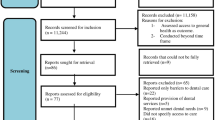Abstract
Data sources PubMED Medical Literature Analysis and Retrieval System online (MEDLINE), Web of Knowledge/Science (WoK/WoS), Psychological Information Databases (PsycINFO) and Excerpta Medica database (EMBASE).
Study selection Limited to articles published between 2008 and 2018, following the previous systematic review up to 2008 (Anders and Davis 2010). The first reviewer screened articles, using clear inclusion and exclusion criteria, and a random selection of 10% of articles were checked by the second reviewer for inconsistencies.
Data extraction and synthesis Data extracted using a pre-prepared database. Independent quality assessment of included articles was undertaken using the Oxford Critical Appraisal Skills Programme (CASP) Checklist of 12 questions, resulting in a total CASP 'score'. A second reviewer checked CASP appraisal of 10% of articles, to discuss and resolve any discrepancies found. Kappa statistics indicated almost perfect agreement between the two reviewers (Cohen's k: 0.88). Results included the country of study, methodology, population characteristics, key study findings, and the study's quality.
Results Thirty three studies were included, and quality assessments indicated 17 articles were of strong quality (CASP score 8+). Oral examination findings were presented in 28 studies. Nine studies indicated a high prevalence of decayed teeth, with ten studies indicating untreated decay. Many studies included DMFT scores, with the missing component relatively high. Almost all studies reported poor oral hygiene levels and gingival health, regardless of ID population characteristics. The prevalence of periodontitis was reviewed in ten studies, ranging between 22.5% and 69.2%, with one study finding a high degree of periodontitis in every age group. Two studies demonstrated adults with ID experience higher rates of edentulism, compared to the general population, despite attending a dentist. Poor quality of life associated with oral disease was reported in two studies. In three studies, which included adults with ID in either community-based or institution settings, poorer oral health was reported for those living in an institution. Two studies investigated the effects of periodontal treatment, both demonstrating positive health outcomes.
Conclusions Studies indicated adults with ID still experience poor oral health, with a high level of unmet dental need, despite improvements in care provision. There are limitations to this review, including study design. This patient group present with many confounding factors that influence oral health, including manual dexterity and co-morbidities, however, only 19 studies considered these factors. However, the need to reduce oral health inequalities globally can be extrapolated, with recommendations of improvement in access to dental services, training and resources of general dental practitioners to improve the oral health of adults with ID. Further studies are needed, with robust study design, to include confounding factors.
This is a preview of subscription content, access via your institution
Access options
Subscribe to this journal
Receive 4 print issues and online access
$259.00 per year
only $64.75 per issue
Buy this article
- Purchase on Springer Link
- Instant access to full article PDF
Prices may be subject to local taxes which are calculated during checkout
Similar content being viewed by others
Author information
Authors and Affiliations
Corresponding author
Rights and permissions
About this article
Cite this article
Kelly, G. How do intellectual disabilities affect oral health?. Evid Based Dent 21, 26–27 (2020). https://doi.org/10.1038/s41432-020-0083-9
Published:
Issue Date:
DOI: https://doi.org/10.1038/s41432-020-0083-9



